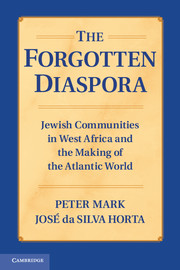Book contents
- Frontmatter
- Contents
- List of Illustrations
- Acknowledgments
- Introduction
- 1 Two Sephardic Communities on Senegal's Petite Côte
- 2 Jewish Identity in Senegambia
- 3 Religious Interaction
- 4 The Blade Weapons Trade in Seventeenth-Century West Africa
- 5 The Luso-African Ivories as Historical Source for the Weapons Trade and for the Jewish Presence in Guinea of Cape Verde
- 6 The Later Years
- Conclusion
- Appendix I The Jewish Traders of Porto d'Ale and Joal, Their Relatives, and Some of Their New Christian Partners in Senegambia and in the United Provinces and Portugal: A Comprehensive List (ca. 1606–ca. 1635)
- Appendix II A Chronological Outline of the Institutional Proceedings against the Jews of Porto d'Ale and Joal (1611–1643)
- Bibliography
- Index
Appendix II - A Chronological Outline of the Institutional Proceedings against the Jews of Porto d'Ale and Joal (1611–1643)
Published online by Cambridge University Press: 03 May 2011
- Frontmatter
- Contents
- List of Illustrations
- Acknowledgments
- Introduction
- 1 Two Sephardic Communities on Senegal's Petite Côte
- 2 Jewish Identity in Senegambia
- 3 Religious Interaction
- 4 The Blade Weapons Trade in Seventeenth-Century West Africa
- 5 The Luso-African Ivories as Historical Source for the Weapons Trade and for the Jewish Presence in Guinea of Cape Verde
- 6 The Later Years
- Conclusion
- Appendix I The Jewish Traders of Porto d'Ale and Joal, Their Relatives, and Some of Their New Christian Partners in Senegambia and in the United Provinces and Portugal: A Comprehensive List (ca. 1606–ca. 1635)
- Appendix II A Chronological Outline of the Institutional Proceedings against the Jews of Porto d'Ale and Joal (1611–1643)
- Bibliography
- Index
Summary
The situation that prevailed on the Petite Côte, outlined by Sebastião Fernandes Cação ca. 1608 in Madrid as part of his Relación, shortly thereafter came to the attention of Philip III and the government of Portugal, as well as to the attention of the “Companhia de Jesus.” The religious question became mixed with economic and administrative issues, and with the judicial inquiry into the activity of the contratador João Soeiro, particularly his activities relating to commerce with the Dutch through the intermediary of his brother in Amsterdam. The question of the participation of the Jews on the coast in commerce with foreigners, including the English and the French, is raised again in an opinion about an undated petition of the Municipal Chamber of Ribeira Grande (Cape Verde Islands). This petition dates to 1610–1615 (MMA, IV, p. 563). The issue is also raised in the reports of at least four governors of Cape Verde before 1640. What follows is a chronological reconstruction of the manner in which the communities of Porto d'Ale and Joal entered the consciousness of local and metropolitan Portuguese institutions, and how those bodies responded.
A letter dated November 1611 from Philip III to the government of Portugal concerning an inquiry by the Conselho da Índia mentions an opinion of the Governor of Cape Verde, D. Francisco de Sequeira, “about people of the nation of New Christians who live as public Jews on the coast of Guiné.”
- Type
- Chapter
- Information
- The Forgotten DiasporaJewish Communities in West Africa and the Making of the Atlantic World, pp. 221 - 224Publisher: Cambridge University PressPrint publication year: 2011



